NVIDIA’s GeForce GTX 480 and GTX 470: 6 Months Late, Was It Worth the Wait?
by Ryan Smith on March 26, 2010 7:00 PM EST- Posted in
- GPUs
Image Quality & AA
When it comes to image quality, the big news from NVIDIA for Fermi is what NVIDIA has done in terms of anti-aliasing of fake geometry such as billboards. For dealing with such fake geometry, Fermi has several new tricks.
The first is the ability to use coverage samples from CSAA to do additional sampling of billboards that allow Alpha To Coverage sampling to fake anti-alias the fake geometry. With the additional samples afforded by CSAA in this mode, the Fermi can generate additional transparency levels that allow the billboards to better blend in as properly anti-aliased geometry would.
The second change is a new CSAA mode: 32x. 32x is designed to go hand-in-hand with the CSAA Alpha To Coverage changes by generating an additional 8 coverage samples over 16xQ mode for a total of 32 samples and giving a total of 63 possible levels of transparency on fake geometry using Alpha To Coverage.
In practice these first two changes haven’t had the effect we were hoping for. Coming from CES we thought this would greatly improve NVIDIA’s ability to anti-alias fake geometry using cheap multisampling techniques, but apparently Age of Conan is really the only game that greatly benefits from this. The ultimate solution is for more developers of DX10+ applications to enable Alpha To Coverage so that anyone’s MSAA hardware can anti-alias their fake geometry, but we’re not there yet.
So it’s the third and final change that’s the most interesting. NVIDIA has added a new Transparency Supersampling (TrSS) mode for Fermi (ed: and GT240) that picks up where the old one left off. Their previous TrSS mode only worked on DX9 titles, which meant that users had few choices for anti-aliasing fake geometry under DX10 games. This new TrSS mode works under DX10, it’s as simple as that.
So why is this a big deal? Because a lot of DX10 games have bad aliasing of fake geometry, including some very popular ones. Under Crysis in DX10 mode for example you can’t currently anti-alias the foliage, and even brand-new games such as Battlefield: Bad Company 2 suffer from aliasing. NVIDIA’s new TrSS mode fixes all of this.

Bad Company 2 DX11 Without Transparency Supersampling
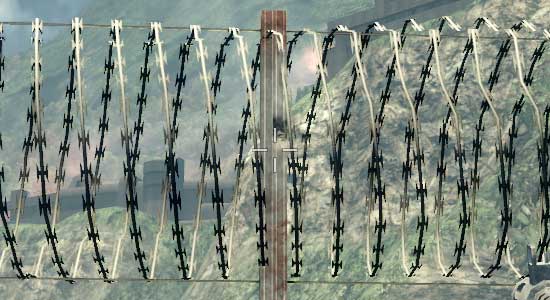
Bad Company 2 DX11 With Transparency Supersampling
The bad news is that it’s not quite complete. Oh as you’ll see in our screenshots it works, but the performance hit is severe. It’s currently super-sampling too much, resulting in massive performance drops. NVIDIA is telling us that this should be fixed next month, at which time the performance hit should be similar to that of the old TrSS mode under DX9. We’ve gone ahead and taken screenshots and benchmarks of the current implementation, but keep in mind that performance should be greatly improving next month.
So with that said, let’s look at the screenshots.

| NVIDIA GeForce GTX 480 | NVIDIA GeForce GTX 285 | ATI Radeon HD 5870 | ATI Radeon HD 4890 |
| 0x | 0x | 0x | 0x |
| 2x | 2x | 2x | 2x |
| 4x | 4x | 4x | 4x |
| 8xQ | 8xQ | 8x | 8x |
| 16xQ | 16xQ | DX9: 4x | DX9: 4x |
| 32x | DX9: 4x | DX9: 4x + AAA | DX9: 4x + AAA |
| 4x + TrSS 4x | DX9: 4x + TrSS | DX9: 4x + SSAA | |
| DX9: 4x | |||
| DX9: 4x + TrSS |
With the exception of NVIDIA’s new TrSS mode, very little has changed. Under DX10 all of the cards produce a very similar image. Furthermore once you reach 4x MSAA, each card producing a near-perfect image. NVIDIA’s new TrSS mode is the only standout for DX10.
We’ve also include a few DX9 shots, although we are in the process of moving away from DX9. This allows us to showcase NVIDIA’s old TrSS mode, along with AMD’s Adapative AA and Super-Sample AA modes. Note how both TrSS and AAA do a solid job of anti-aliasing the foliage, which makes it all the more a shame that they haven’t been available under DX10.
When it comes to performance, keep in mind that both AMD and NVIDIA have been trying to improve their 8x MSAA performance. When we reviewed the Radeon 5870 back in September we found that AMD’s 8x MSAA performance was virtually unchanged, and 6 months later that still holds true. The performance hit moving from 4x MSAA to 8x MSAA on both Radeon cards is roughly 13%. NVIDIA on the other hand took a stiffer penalty under DX10 for the GTX 285, where there it fell by 25%. But now with NVIDIA’s 8x MSAA performance improvements for Fermi, that gap has been closed. The performance penalty for moving to 8x MSAA over 4x MSAA is only 12%, putting it right up there with the Radeon cards in this respect. With the GTX 480, NVIDIA can now do 8x MSAA for as cheap as AMD has been able to
Meanwhile we can see the significant performance hit on the GTX 480 for enabling the new TrSS mode under DX10. If NVIDIA really can improve the performance of this mode to near-DX9 levels, then they are going to have a very interesting AA option on their hands.
Last but not least, there’s anisotropic filtering quality. With the Radeon 5870 we saw AMD implement true angle-independent AF and we’ve been wondering whether we would see this from NVIDIA. The answer is no: NVIDIA’s AF quality remains unchanged from the GTX200 series. In this case that’s not necessarily a bad thing; NVIDIA already had great AF even if it was angle-dependant. More to the point, we have yet to find a game where the difference between AMD and NVIDIA’s AF modes have been noticeable; so technically AMD’s AF modes are better, but it’s not enough that it makes a practical difference
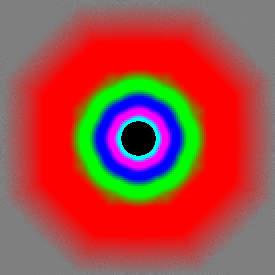
GeForce GTX 480

GeForce GTX 285
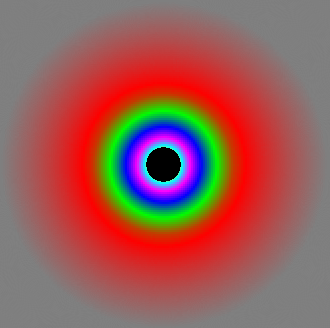
Radeon 5870


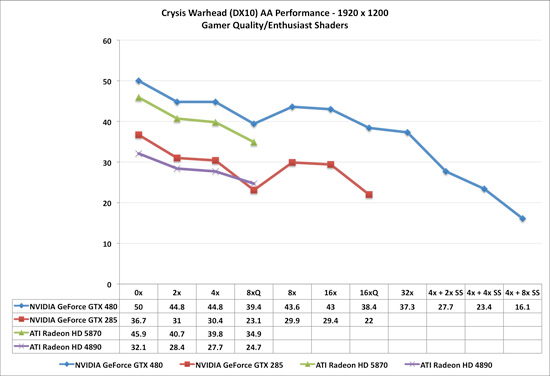
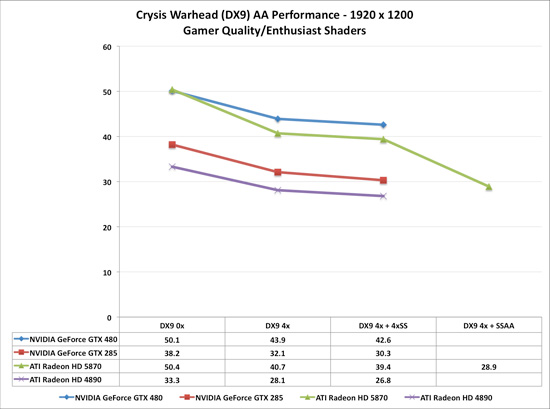








196 Comments
View All Comments
deputc26 - Friday, March 26, 2010 - link
"GTX 480 only has 11% more memory bandwidth than the GTX 285, and the 15% less than the GTX 285."and holy server lag batman.
529th - Friday, March 26, 2010 - link
Thanks for the review :)ghost2code - Saturday, March 27, 2010 - link
I'm really impressed by this article author made a great job;) But about Fermi It's seem to be really good product for scientific matters but for gamers I'm not so sure about that. The price tag, power consumption, noise! this all is to much for only 10-15% of power more than above the cheaper and much more reasonable in all this things Radeon. I guess Fermi need some final touch from Nvidia and for now it's not a final , well tested product. Temp around 100 it's not good for PCB, GPU and all electronic and I don't believe it want metter for time-life and stability of the card. I'm glad the Farmi finally came but I'm dissapointed at least for now.LuxZg - Saturday, March 27, 2010 - link
I just don't know why GTX480 is compared to HD5870, and same for GTX470 vs HD5850.. GTX470 is right in the middle between two single-GPU Radeons, and just the same can be said for GTX480 sitting right in between HD5970 & HD5870.Prices of this cards as presented by nVidia/ATI:
HD5970 - 599$
GTX480 - 499$
HD5870 - 399$
GTX470 - 349$
HD5850 - 299$
I know GTX480 is single GPU, so by this logic you'll compare it to HD5870. But GTX480 is top of the line nVidia graphics card, and HD5970 is top of the line ATI card. Besides, ATI's strategy for last 3 product cycles is producing small(er) chips and go multi-GPU, while nVidia wants to go single-monolitic-GPU way.. So following this logic, indeed GTX480 should be compared to HD5970 rather than HD5870.
Anyway, conclusion of this article is all fine, telling both strengths and the weaknesses of solutions from both camps, but I believe readers weren't told straightforward enough that these cards don't cost the same... And HD5970 was left out of the most of the comparisions (textual ones).
If I personaly look at these cards, they are all worth their money. nVidia cards are probably more future-proof with their commitment to future tech (tessellation, GPGPU) but AMD cards are better for older and current (and close future) titles. And they are less hot, and less noisy, which most gamers do pay a lot of attention to. Not to say - this is first review of new card in which no one mentioned GPU overclocking. I'm guessing that 90+C temperatures won't allow much better clocks in the near future ;)
Wwhat - Sunday, March 28, 2010 - link
In regards to the temperature and noise: there's always watercooling to go to, I mean if you have so much money to throw at the latest card you might as well thrown in some watercooling too.It's too pricey for me though, I guess I'll wait for the 40nm process to be tweaked, spending so much money on a gfx card is silly if you know a while later something new will come around that's way better, and it's just not worth committing so much money to it in my view.
It's a good card though (when watercooled), nice stuff in it and faster on all fronts, but it also seems an early sample of new roads nvidia went into and I expect they will have much improved stuff later on (if still in business)
LuxZg - Tuesday, March 30, 2010 - link
Like I've said before - if you want FASTEST (and that's usually what you want if you have money to throw away), you'll be buying HD5970. Or you'll be buying HD5970+water cooling as well..ViRGE - Saturday, March 27, 2010 - link
I'm not sure where you're getting that the HD5970 is a $600 card. In the US at least, that's a $700 card (or more) everywhere.wicko - Sunday, March 28, 2010 - link
Honestly I don't even know if it should be mentioned at all even if it is 600, because there is almost no stock anywhere.LuxZg - Tuesday, March 30, 2010 - link
Oh, don't make me laugh, please! :D In that case this review shouldn't be up at all, or it should be called "PREview".. or have you actually seen any stock of GTX470/480 arround?LuxZg - Sunday, March 28, 2010 - link
It's AMD's & nVidia's recommended prices, and you can see them all in Anandtech's own articles:http://www.anandtech.com/video/showdoc.aspx?i=3783">http://www.anandtech.com/video/showdoc.aspx?i=3783 (nvidia prices)
http://www.anandtech.com/video/showdoc.aspx?i=3746">http://www.anandtech.com/video/showdoc.aspx?i=3746 (ATI single-gpu cards)
http://www.anandtech.com/video/showdoc.aspx?i=3679">http://www.anandtech.com/video/showdoc.aspx?i=3679 (ATI single/dual GPU cards)
It is not my fault that your US shops bumped up the price in the complete absence of competition in the high end market. But US is not only market in the world either.
You want to compare with real world prices? Here, prices from Croatia, Europe..
HD5970 - 4290kn = 591€ (recommended is 599$, which is usually 599€ in EU)
GTX480 - not listed, recommended is 499$/€
HD5870 - 2530kn = 348€ (recommended is 399$/399€ in EU)
GTX470 - not listed, recommended is 349$/€
HD5850 - 1867kn = 257€ (recommended is 299$/299€ in EU)
So let's say that European prices for GTX will be a bit lower than recommended ones, GTX480 would still be ~120-130€ pricier than HD5870, and HD5970 would be same ~120-130€ more expensive than GTX480.
As for the lower priced nVidia card, it's again firmly in the middle between HD5850 & HD5870.
Point is that there's no clear price comparision at the moment, and article's conclusion should be clear on that.
Person that wants the FASTEST CARD will stretch for another 100$/€ to buy HD5970. Especially since this means lower noise, lower consumption, and lower heat. This all combined means you can save a few $/€ on PSU, case, cooling, and earplugs, throwing HD5970 in the arm reach of the GTX480 (price-wise) while allowing for better speeds.
As for GTX470, again, lower consumption/heat/noise with ATI cards which means less expenses for PSU/cooling, and saving money on electrical bills. For me, well worth the 50€/$ difference in price, in fact, I'd rather spend 50$/€ more to buy HD5870 which is faster, less noisy, doesn't require me to buy new PSU (I own HD4890, which was overclocked for a while, so HD5870 would work fine just as well), and will save me 50W per hour of any game I play.. which will all make it CHEAPER than GTX470 in the long run.
So let's talk again - why isn't conclusion made a bit more straightforward for end users, and why is HD5890 completely gone from the conclusion??